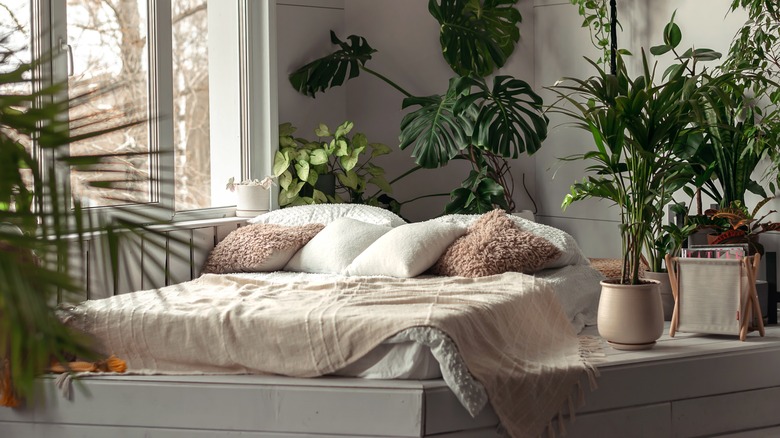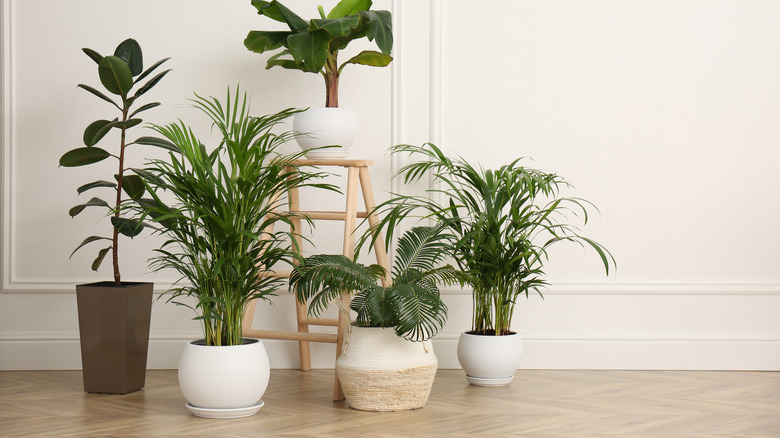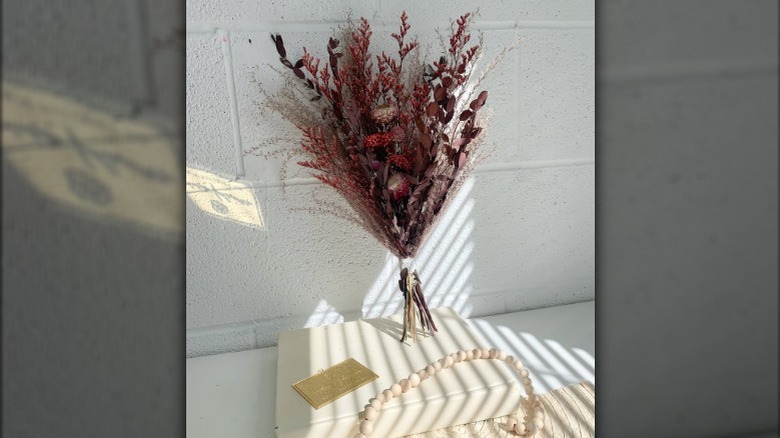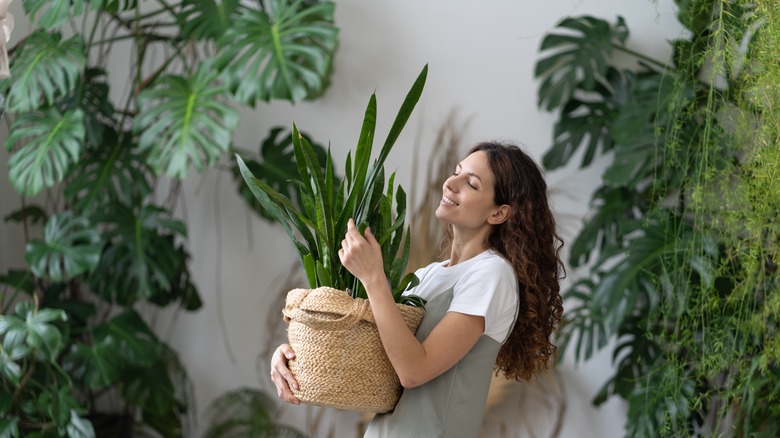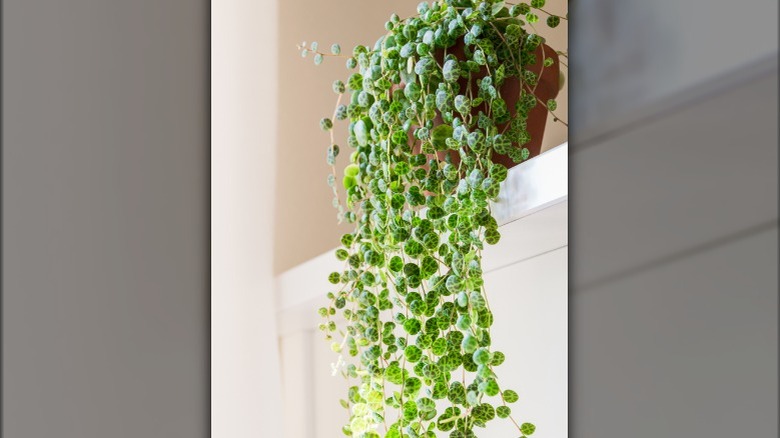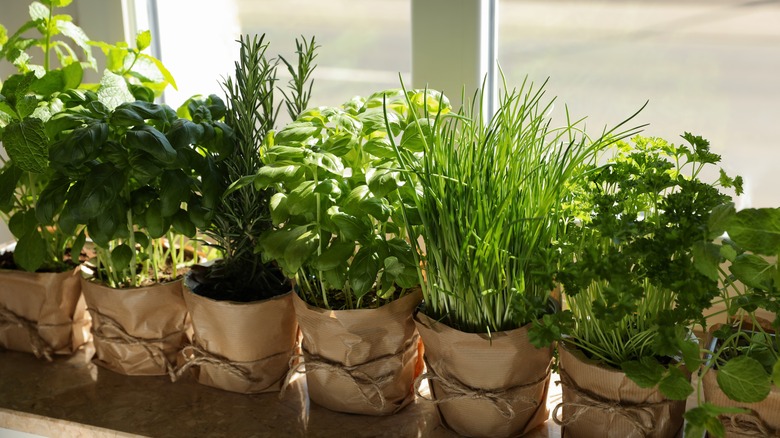How To Incorporate Indoor Foliage In Your Home Décor
Is there anything as refreshing or aesthetically pleasing as indoor foliage? Even if you're allergic to real plants, there are many ways to include flora in your home décor, and the effect is nothing short of mesmerizing. Whether you have a green thumb and want all the indoor plants or prefer more subtle vegetation, there are plenty of options for introducing foliage.
Additionally, if you're hunting for seasonal additions that will brighten or elevate a certain room or space or simply want to bring your favorite plants inside, you can get as creative as you want. A maximum or minimal approach doesn't really exist when it comes to foliage as long as it suits your needs and vision. There are also several benefits to decorating with plants, including improved mental wellness that comes from taking care of something, according to Vitesy. With that in mind, here are a few exciting ways to introduce greenery into your home, and many of them work with any interior design or aesthetic.
Bigger is better
If you haven't jumped on the "big plant" bandwagon, you might consider investing in a larger statement piece. There is no question that flora offers many benefits in the home, including better air quality and stress relief, but they also contribute to style. Oversized greenery, like fiddle trees, monstera, and snake plants, all create a focal point in any room they inhabit. By adopting one of these, you're easily inserting a statement piece while improving your household's quality of life.
Another bonus for using larger plant species is noise reduction. According to Ambius, your green friends can actually absorb sound, and everything from the stems to the leaves help minimize noises. If your windows let in outside sounds, place a plant by it. Thicker leaves or bark are beneficial with noise. Instead of the standard fiddle in the corner of the room, why not purchase a natural or artificial olive tree? Lantern Lane Designs notes that this new interior tree trend offers a light and airy vibe while providing a stylish focal piece.
Dried designs
You might love the idea of introducing more foliage into your home, only to stop and think about the care required to keep them alive. Fret not because you aren't alone worrying about being a full-time plant parent. There are many alternatives to living species, but dried foliage is one of the biggest trending options. Studio Jeandré notes that natural yarrow, wheat, and dried flowers last long and offer a chic and rustic backdrop to any room.
You can pop these in a vase or jar on tables and other surfaces throughout your home or hang them from hooks as wall décor. However you choose to display your dried foliage, it is sure to be an impressive addition that pulls your theme together and adds a touch of textured magic. Acquiring dried flowers and stocks is relatively easy; you can do it yourself by grabbing some wildflowers outdoors or visiting your local florist. Online shops like Etsy also provide bundles. To DIY dried bouquets, tie the stems up with string, then hang them upside down in your pantry or another dry, dimly lit space for two to three weeks. This will remove moisture without making them too brittle too quickly. Drying is the game's name, but they shouldn't be so stiff they crumble to the touch.
Become a plant parent
While this next suggestion might fall into the obvious pile, sticking with a classic never hurts. Buying living plants and setting them up around the house is the surest way to invite cleaner air into your space. Time recommends having two substantial-sized plants every 100 square feet in the home if you're aiming to improve air quality. You can also get creative with the vases and holders, using different shapes and sizes to add depth to any room. Find pots that color coordinate with your aesthetic, or look for statement pieces that serve as conversation starters.
Numerous plant species require little effort if you don't boast a green thumb. Chinese money plants, snake plants, and philodendrons are a few examples. The snake plant thrives off negligence, doing better when left to its own devices. Many self-reliant species only need to be watered when the soil has gone dry and can survive for weeks without any interaction. Always check the care requirements, especially to know about sunlight conditions. On the other hand, if you love to nurture things, growing indoor plants is rewarding and fun. Every room doesn't have to feature greenery, but they can be addictive, so be mindful when shopping.
Shower your bathroom with succulents
Succulents are a wonderful option for veteran plant parents or newbies because they can survive and thrive in most settings and don't require much care. Not only are they relatively low maintenance, but they look fantastic in kitchens and bathrooms. One way to include foliage in your home is with succulents, specifically the longer species that grow out and trail down walls, counters, or shelves. If you want to bring more green into your home but don't have space in your bedrooms or living spaces, why not try the bathroom?
Trailing succulents can be placed on cabinets, shelves, or alcoves in your washroom. The vines will create a zen, garden-like atmosphere that will instantly elevate your space and give it a spa quality. You'll feel like you're rinsing off in a Bali oasis every time you go in, and the moisture from the shower can help water these plants without overdoing it. Avoid giving them too much humidity by turning on the fan while the water runs and leaving the door open to disperse steam afterward. According to Succulents Box, these plants don't do well in constant high humidity, but shorter bursts are fine and won't cause fungus.
Helpful herbs
Plants don't only have to provide epic backdrops and calming views; they also offer uses beyond those listed above. Installing a small herb garden is another way to bring foliage into your home, and it doubles as a helpful tool in the kitchen. Mint, thyme, dill, oregano, and basil are all herbs that add delicious flavors to your food, and growing them yourself adds the extra flavor of pride. Your cooking space might be the first spot you think of to include foliage, and it is one of the most useful spaces to grow herbs.
To successfully create your own kitchen garden, Oregon Live suggests keeping the room where they will live between 55 to 75 degrees Fahrenheit at all times. Some species will need five or six hours of sunlight, but depending on the time of year, they shouldn't be left too close to windows to avoid sun or freeze damage. Seed packets will come with recommendations and instructions, setting you up for a winning garden that doubles as a green kitchen addition. Happy planting, growing, and decorating!
